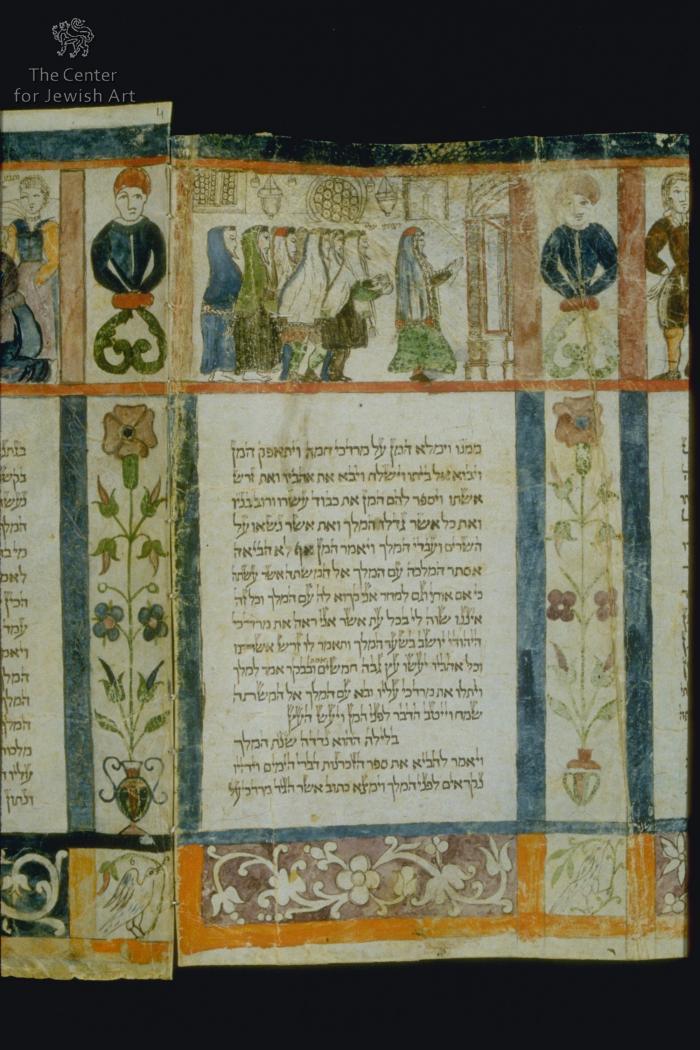Obj. ID: 66 NLI Moshe ben Avraham Pescarolo Esther Scroll, Ferrara, 1616

One of three currently known lavishly illustrated scrolls produced by Moshe ben Avraham Pescarolo. The opening sheet of the scroll is trimmed into a conical shape on which the inscription in Hebrew is inscribed (see ID 2739). The rectangular text panels are surrounded by a variety of decorative motifs. The upper margin of each membrane is filled with figurative scenes in rectangular frames depicting the narrative of the Book of Esther supplemented with midrashic tales. They are captioned in Hebrew with short quotations from the Book of Esther or clear references to this text. The scenes are separated by stylized herms, resembling male or female half-figures, each resting on a pedestal of inverted volutes. The lower margin - which is narrower than the upper one - is decorated with panels containing foliate scrolls - some with animals, hybrids, birds, butterflies, fruit, and floral motifs. The text panels are separated by a repeating floral motif: an upright floral branch in a vase. All details are framed in variegated panels.
The scroll is mounted on a wooden handle.
The scroll is composed of 6 sheets, 29 text columns of inconsistent text space (98-117) x (70-80) mm, with 15 lines in most columns. it is written in light brown ink on the flesh side, in square Italo-Sefardic script.
Membranes in the scroll are stitched together.
It was ruled with a stylus, with 2 vertical lines and 15 horizontal lines. Additional ruling for the frames was done in by plummet and ink.
Pricking is not discernible.
The colophon is written on the bottom of column 29 within a blue panel: "מעשה ידי צעיר זעיר משה בכמה"ר(בן כבוד מורנו הרב רבי)אברהם פשקרול זלהה ש’ע’ז’ פה קרית פירארה" "Made by the young Moses son of our honored teacher Rabbi Abraham here in the city of Ferrara, 1616".
The artist's family had immigrated from Germany to Italy one generation before Moshe ben Avraham, and some of its members were book printers.
In scholarly literature, different spellings of the surname can be found; the most popular are Pescarol and Pescarolo. Other variants include: Pascarolo, Pascarol ("פַּשְׂקַרוֹל"), Piscarol, Pescarolo, Poscarel, Poscarela, Pescaroli, Pescaraolo. See M. Mortara, Indice alfabetico dei rabbini e scrittori Israeliti, Padova 1886, p. 49.
This bibliography lists publications on all three currently known megillot Esther made by Moshe ben Avraham Pescarolo:
Florence Mansano Soulam, בסוד מגילותיו של הסופר-המאייר משה בן אברהם פשקרול: ניתוח מגילות פשקרול בתוך הקונטקסט ההיסטורי של איטליה בראשית המאה השבע-עשרה [Unveiling the Secrets of the Scrolls of Moshe Pescarolo Scribe and Artist. An Analysis of Pescarolo’s Scrolls in the Historical Context of Italy in the Early 17th Century], doctoral dissertation: Hebrew University of Jerusalem, 2006.
Mendel Metzger, The John Rylands Megillah and Some Other Illustrated Megilloth of the 15th to 17th Centuries, "Bulletin of the John Rylands Library" 1962 (45), 148–184, esp. 166–171.
Dagmara Budzioch, The Decorated Esther Scrolls from the Museum of the Jewish Historical Institute in Warsaw and the Tradition of Megillot Esther Decoration in the Seventeenth and Eighteenth Centuries – An Outline [Polish: Dekorowane zwoje Estery z Żydowskiego Instytutu Historycznego w Warszawie na tle tradycji dekorowania megillot Ester w XVII i XVIII wieku. Zarys problematyki], Warsaw 2019, 1:89-92.
Dagmara Budzioch, Midrashic Tales in Seventeenth and Eighteenth-century Illustrated Esther Scrolls, "Kwartalnik Historii Żydów” 2017, no 3 (263), 405–422, esp. 408, 410, 411, 414, 415.
Dagmara Budzioch, Italian Origins of the Decorated Scrolls of Esther, "Kwartalnik Historii Żydów" 2016, no 1 (257), 35–49, esp.. 40–43.
A Spectacular 400 Year-Old Scroll of Esther available on https://blog.nli.org.il/en/book-of-esther-ferrera/ (accessed on 16.10.2020).
















